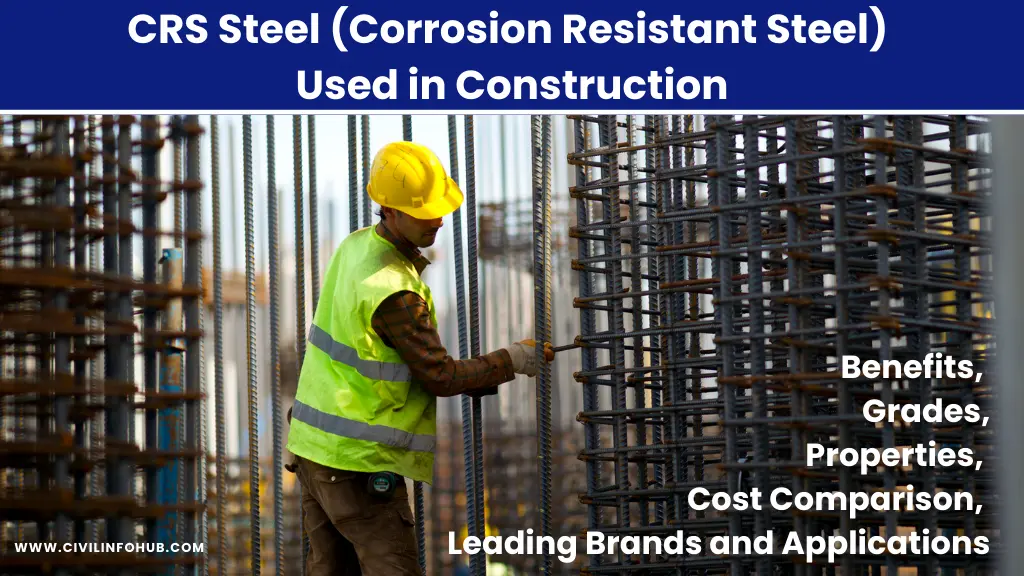CRS Reinforcement Steel : Corrosion Resistant Steel (CRS) is a type of reinforcement steel specially designed to resist corrosion in aggressive environments such as coastal regions, industrial areas, and high-humidity zones. It is alloyed with elements like copper, chromium, and phosphorus, which form a protective layer on the steel surface, slowing down rust formation and improving structural life.
In this blog, we will cover what CRS reinforcement steel is, available grades (Fe415, Fe500, Fe550, Fe550D), chemical composition, benefits, applications, and cost difference compared to conventional steel.
What is CRS Reinforcement Steel?
CRS reinforcement steel is a corrosion-resistant version of Thermo-Mechanically Treated (TMT) steel. It is manufactured with specific alloying elements to enhance its resistance to moisture, chloride ions, and industrial pollutants. These bars are particularly suited for:
- Bridges, marine structures, and ports
- Coastal buildings and apartments
- Industrial infrastructure in chemical zones
- Water-retaining structures like tanks and dams
Grades of CRS Reinforcement Steel
CRS steel is available in multiple grades, similar to regular TMT bars, to cater to different strength requirements:
| Grade | Yield Strength (MPa) | Typical Use Case |
|---|---|---|
| Fe415 | 415 MPa | Residential projects, low-rise buildings, and moderate-load structures |
| Fe500 | 500 MPa | Mid to high-rise buildings, general construction |
| Fe550 | 550 MPa | Heavy-load structures, industrial buildings |
| Fe550D | 550 MPa (with higher ductility) | Earthquake-prone areas, structures needing extra flexibility |
Below are the some of grades of CRS steel manufactured by JSW Steel.
| Grade | Yield Strength (MPa) | UTS / YS Ratio | Elongation (%) | Max Carbon (%) | Max Sulphur (%) | Max Phosphorus (%) | Max CE (%) | Special Feature |
|---|---|---|---|---|---|---|---|---|
| Fe 500D CRS | 500 | ≥ 1.08 | ≥ 16 | 0.14 | 0.03 | 0.10 | 0.50 | High strength with corrosion resistance; suitable for coastal & humid zones |
| Fe 550D CRS | 550 | ≥ 1.06 | ≥ 14.5 | 0.15 | 0.03 | 0.08 | 0.45 | Higher load capacity; ideal for industrial & infrastructure projects |
| Fe 600 CRS | 600 | ≥ 1.06 | ≥ 12 | 0.15 | 0.04 | 0.08 | 0.45 | Maximum strength for specialized heavy-load structures |
For more details kindly check the given link : https://www.jswneosteel.in/products/jsw-neosteel-crs.aspx
Chemical Composition of CRS Steel
Following are the Chemical composition of CRS Steel
| Element | Percentage Range |
|---|---|
| Carbon (C) | 0.10 – 0.25% |
| Manganese (Mn) | 0.30 – 0.70% |
| Copper (Cu) | 0.20 – 0.40% |
| Chromium (Cr) | 0.40 – 0.80% |
| Phosphorus (P) | 0.05 – 0.10% |
| Sulphur (S) | ≤ 0.05% |
Leading CRS Brands in India
| Brand / Company | Market Cap (₹ Crore) | Notable for |
|---|---|---|
| JSW Steel (CRS offerings) | ₹2,52,700 Cr | Among the top CRS producers; world’s most valuable steelmaker with ~$30.3B market cap (Companies Market Cap, Business Standard) |
| Tata Steel (CRS offerings) | ₹2,00,000 Cr approx. | Major national steel player with CRS grades in portfolio (The Economic Times, Value Research Online) |
| Jindal Steel & Power | ₹1,00,800 Cr | Offers CRS variants under its TMT range (Value Research Online) |
| Jindal Stainless | ₹55,500 Cr | Known for stainless steel; also explores alloy-type CRS bars (ICICI Direct) |
| SAIL (Steel Authority of India Ltd) | Not precisely stated | Government-owned producer; may supply CRS or corrosion-resistant TMT variants (Wikipedia) |
Why Corrosion is a Problem in Reinforced Concrete
When ordinary steel bars come into contact with moisture, oxygen, and chlorides, rust forms. This rust occupies more volume than steel, causing internal pressure in concrete, leading to cracks, spalling, and structural weakness.
CRS steel delays this process, allowing the structure to remain stronger for decades, especially in high-corrosion zones like coastal cities.
Benefits of CRS Reinforcement Steel
- Superior Corrosion Resistance – Alloying elements create a protective film on the surface, resisting chloride attack.
- Extended Service Life – CRS bars can double the life of structures in harsh environments.
- High Strength & Durability – Available in Fe415 to Fe550D, meeting IS 1786 standards.
- Better Bond with Concrete – Ribbed surface ensures a strong grip, preventing slippage.
- Lower Maintenance Cost – Reduces frequent repair needs due to rust damage.
- Ideal for Harsh Environments – Perfect for coastal, industrial, and humid areas.
Applications of CRS Steel
- Coastal residential and commercial projects
- Bridges, flyovers, and highways near water bodies
- Ports, jetties, and marine facilities
- Water treatment plants and sewage systems
- Industrial manufacturing units in chemical zones
Cost Comparison – CRS Steel vs Primary Steel
While CRS steel offers better corrosion resistance, it comes at a slightly higher cost than conventional primary TMT steel.
Below is a cost difference summary (illustrative market rates, subject to region and time):
| Steel Type | Grade | Approx. Price (₹/MT) | Difference from Primary Steel |
|---|---|---|---|
| Primary TMT Steel | Fe500 | ₹58,000 – ₹60,000 | — |
| CRS Steel | Fe500 | ₹60,500 – ₹63,000 | ₹3,500 – ₹4,500 more per MT |
| Primary TMT Steel | Fe550D | ₹59,000 – ₹61,000 | — |
| CRS Steel | Fe550D | ₹61,500 – ₹64,000 | ₹3,500 – ₹4,500 more per MT |
Note:
- CRS steel costs 4–5% higher than primary steel.
- The additional cost is compensated by longer service life and reduced maintenance.
CRS Steel vs Conventional TMT Steel – Quick Comparison
| Feature | CRS Steel | Conventional TMT Steel |
|---|---|---|
| Corrosion Resistance | High | Moderate |
| Initial Cost | Slightly Higher | Lower |
| Maintenance Cost | Low | High |
| Coastal Suitability | Excellent | Poor |
| Grades Available | Fe415, Fe500, Fe550, Fe550D | Fe415, Fe500, Fe550, Fe550D |
Tips for Using CRS Steel
- Store bars above ground and covered until use.
- Use adequate concrete cover as per IS 456 to protect steel further.
- Avoid mixing CRS with non-CRS in the same structural element.
- Always follow structural engineer’s specifications.
Conclusion
CRS reinforcement steel, available in grades Fe415, Fe500, Fe550, and Fe550D, is an excellent choice for structures in aggressive environments. While it costs slightly more than regular TMT steel, it offers unmatched durability, lower maintenance, and better long-term value. For coastal projects, marine structures, and industrial zones, CRS is not just an option — it’s the smartest investment.
Disclaimer
This blog is for informational purposes only. Always consult a licensed structural engineer and refer to approved drawings before making procurement decisions.
FAQs – CRS Reinforcement Steel in Construction
1. What is CRS reinforcement steel?
CRS (Corrosion Resistant Steel) reinforcement steel is a type of TMT bar manufactured with special alloying elements like copper, chromium, and phosphorus to resist corrosion. It is ideal for structures in coastal, industrial, and humid environments.
2. What are the available grades of CRS steel?
CRS steel is available in grades Fe415, Fe500, Fe550, and Fe550D.
- Fe415 – Suitable for low-rise buildings and moderate loads.
- Fe500 – Commonly used in mid to high-rise construction.
- Fe550 – Used for heavy-duty and industrial structures.
- Fe550D – Offers higher ductility, suitable for earthquake-prone areas.
3. How is CRS steel different from regular TMT steel?
The main difference is corrosion resistance. CRS steel has alloying elements that form a protective film against rust, while regular TMT steel is more prone to corrosion in harsh environments. CRS steel typically lasts longer and requires less maintenance.
4. Where is CRS reinforcement steel used?
CRS steel is commonly used in:
- Coastal buildings and apartments
- Marine structures like ports and jetties
- Bridges and flyovers
- Water tanks, dams, and treatment plants
- Industrial plants in chemical or humid zones
5. What is the cost difference between CRS steel and primary steel?
CRS steel is usually ₹3,500–₹4,500 per metric ton more expensive than primary TMT steel. However, the higher cost is balanced by longer service life and reduced maintenance expenses.
6. Does CRS steel completely prevent corrosion?
No material can completely prevent corrosion, but CRS steel significantly slows down the process. With proper design, concrete cover, and maintenance, CRS steel can last decades without significant rust damage.
7. Is CRS steel suitable for inland projects?
Yes. While CRS steel is highly recommended for coastal and industrial environments, it can also be used inland, especially in areas with high rainfall, humidity, or polluted air.
8. What IS code governs CRS reinforcement steel?
CRS steel is manufactured as per IS 1786:2008 (High Strength Deformed Steel Bars and Wires for Concrete Reinforcement), with additional corrosion resistance specifications.
9. How should CRS steel be stored on-site?
Even though it’s corrosion-resistant, CRS steel should be stored off the ground, on wooden planks or supports, and covered with waterproof sheets to avoid unnecessary exposure before use.
10. Is CRS steel worth the extra cost?
Yes. For structures exposed to aggressive conditions, the extended lifespan and reduced maintenance of CRS steel provide far better long-term value compared to conventional steel.
Read More :
https://civilinfohub.com/fly-ash-ggbs-in-ready-mix-concrete/











1 thought on “CRS Reinforcement Steel Used in Construction – Benefits, Grades, Cost Comparison, and Applications : 2025”